Alicante
When marketing creates an icon
Seldom has a tourism marketing campaign so effectively outlived its inventor as that of British European Airways when, to promote their new service to Valencia in 1957, they gave the name 'Costa Blanca' to the sun-soaked coast of Spain that includes Alicante, Benidorm, Xàbia and Dénia.
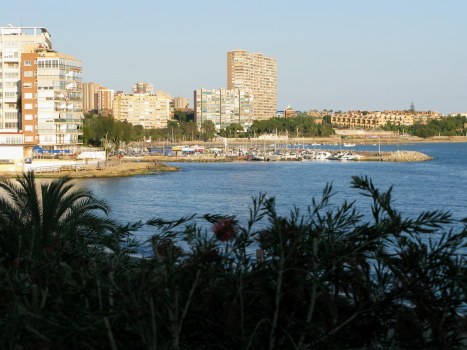
Once 'discovered', the Costa Blanca started to rapidly respond to the impact of tourism on Benidorm and other small towns. Already scarce water supplies had to be supplemented by de-salination plants making sea water 'fresh'.
Tourism remains an important economic generator – creating difficult economic times for Spain and all tourism destinations as a result of the global pandemic.
After a robust rebound, the saturation of tourist impact resulted in a Feb 2025 law being enacted in Alicante that addresses the sound pollution of terrace bars and all night shops
Despite the state of the economy, and the number of villas and apartments for sale (mostly owned by foreign speculators), the world is still drawn to the Costa Blanca to soak up the predictable sunshine and the relaxed atmosphere of the Mediterranean coast
Spared the package tourism onslaught that characterises Benidorm, Alicante is a friendly, relaxed place. It is big enough to be an important Spanish port city, and small enough to have the best characteristics of a village.
How to get there?
Trainline works with 270 rail and coach companies to offer their customers travel to destinations in and across 45 countries in Europe
Alicante: a place of character
Alicante retains the character it has formed over centuries of turbulent history.
Historical remains show that this region was already settled 7000 years ago.
More recently, the Alicante we know today was preceded by the Roman settlement of Lucentum in the 4th century, later becoming an important fortress city during the 400 years of Moorish occupation.
The Moors arrived in 718 and it took until 1492 for them to be overthrown as occupiers.
The Moorish castle, or Castillo was built in the 10th century. It crowns the south-eastern slope of el Monte Benacantil and has given Alicante a hallmark image – that of la cara del moro ('the Moor's Face').
Peering skyward from the coast, what appears to be a Moorish head seems topped by the Castillo sitting like a strange angular hat above his khafia or Arabian headdress.
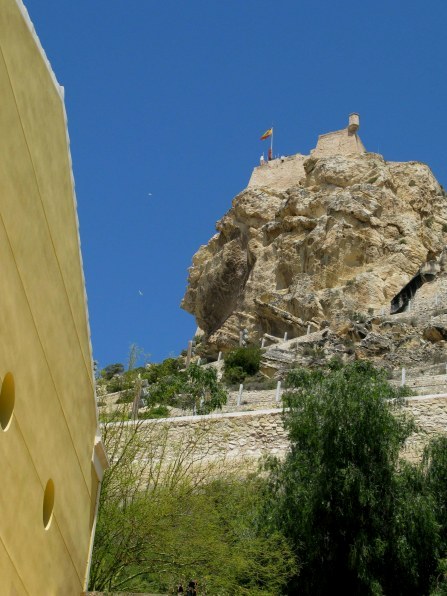
The Pueblo or Old Town of Alicante
The old town or pueblo of Alicante is a maze of narrow streets and alleyways featured more on the 'Pueblo' page of this site. Its stairways and terraces look upwards to the Castillo and downwards to the Mediterranean Sea.
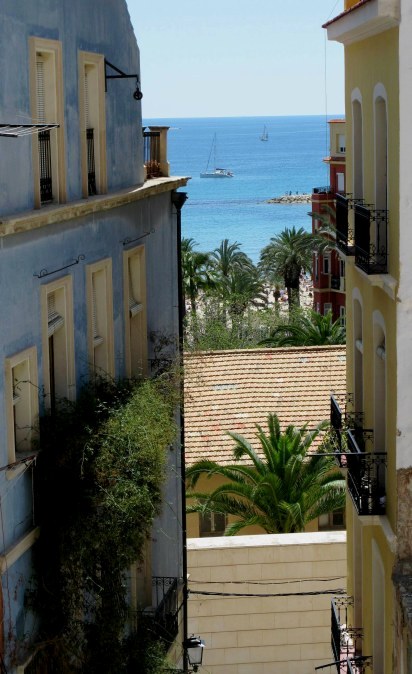
The Pueblo has a unique charm, stamped as it is with authenticity, whether in the signed attestations of admiration from its citizens, as on these stair-side walls…
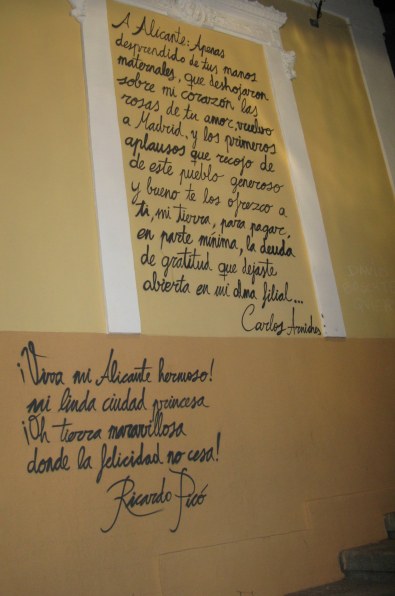
…or in its colourful flower pots, tiles, and house decorations.
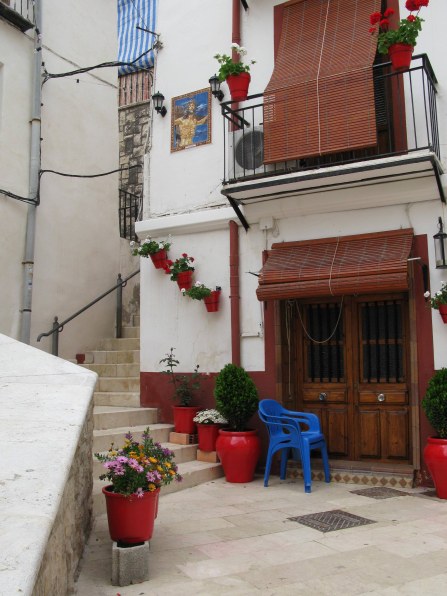
Coastal architecture near Alicante
Throughout the city outside the pueblo, the architecture of today mixes in quirky and not always sympathetic ways with that of grander times.
Further along the coast you find simple and charming small villas from the Spain that was, before the Spain that now is.
These days the coast is fringed with high rise apartment blocks that step along the lovely coastline and seem to have little affinityto it.
I quite fancied this giraffe in Playa de la Albufereta, but could see no relationship between it and its land-locked site of an ocean-side high-rise apartment block.I felt it could at least have stood where it could gaze across to the Levant.
The sense of the giraffe being out of place reminds me how much high-rise development of formerly remote and wild places is a hallmark of our modern world.
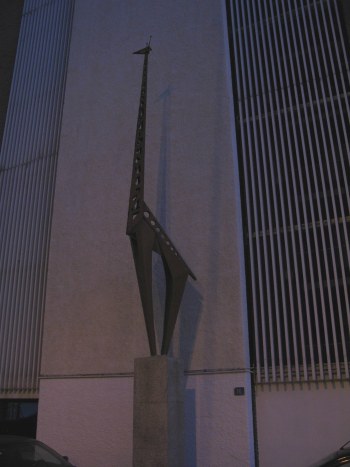
Henry Beston, the American writer and naturalist, echoes the sentiments of many of us in having written :
The three great elemental sounds in nature are the sound of rain,
the sound of wind in a primeval wood,
and the sound of outer ocean on a beach.
I have heard them all,
and of the three elemental voices,
that of ocean is the most awesome, beautiful, and varied.
I feel sad for the
natural coast around the Alicante
of former times, when there once was the opportunity for a small cottage to host all
three of these sounds in a sort of splendid isolation.
Alicante mixed architectural heritage
Within the city of Alicante itself, the mix of old and new is sometimes a bit discordant, but seldom dull.
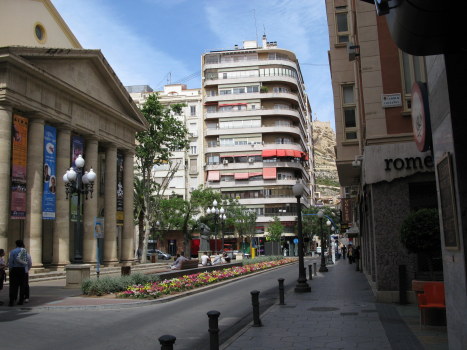
Neo-classical sits cheek by jowl with modern apartment blocks where each floor seems to have grown its own peculiar style of wart.
In the smaller street leading to the pueblo ancient style and modern design blend more happily together.
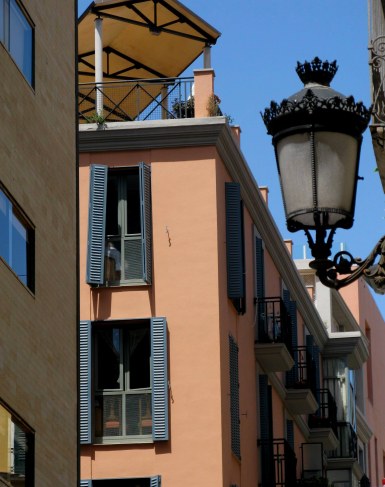
Art Deco and Art Nouveau in Alicante
The art deco period has a distinct influence in Alicante, with a particular type of iridescent tile featuring in several city building like this one.
Iridescent tiles (Porcelánico Iridiscente o nacarado) are something of a Spanish specialty but they make practical good sense too. The way they are fired makes them extremely water resistant.
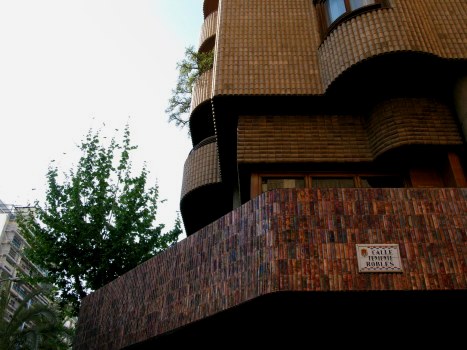
Valencian Art Nouveau is a particular variety of the period style: in Spanish called modernismo valenciano and in Valencian modernisme valencià.
There are several outstanding examples in Alicante. Here is the beautiful staircase of the Casa Modernista de Novelda (The modern house of Novelda)
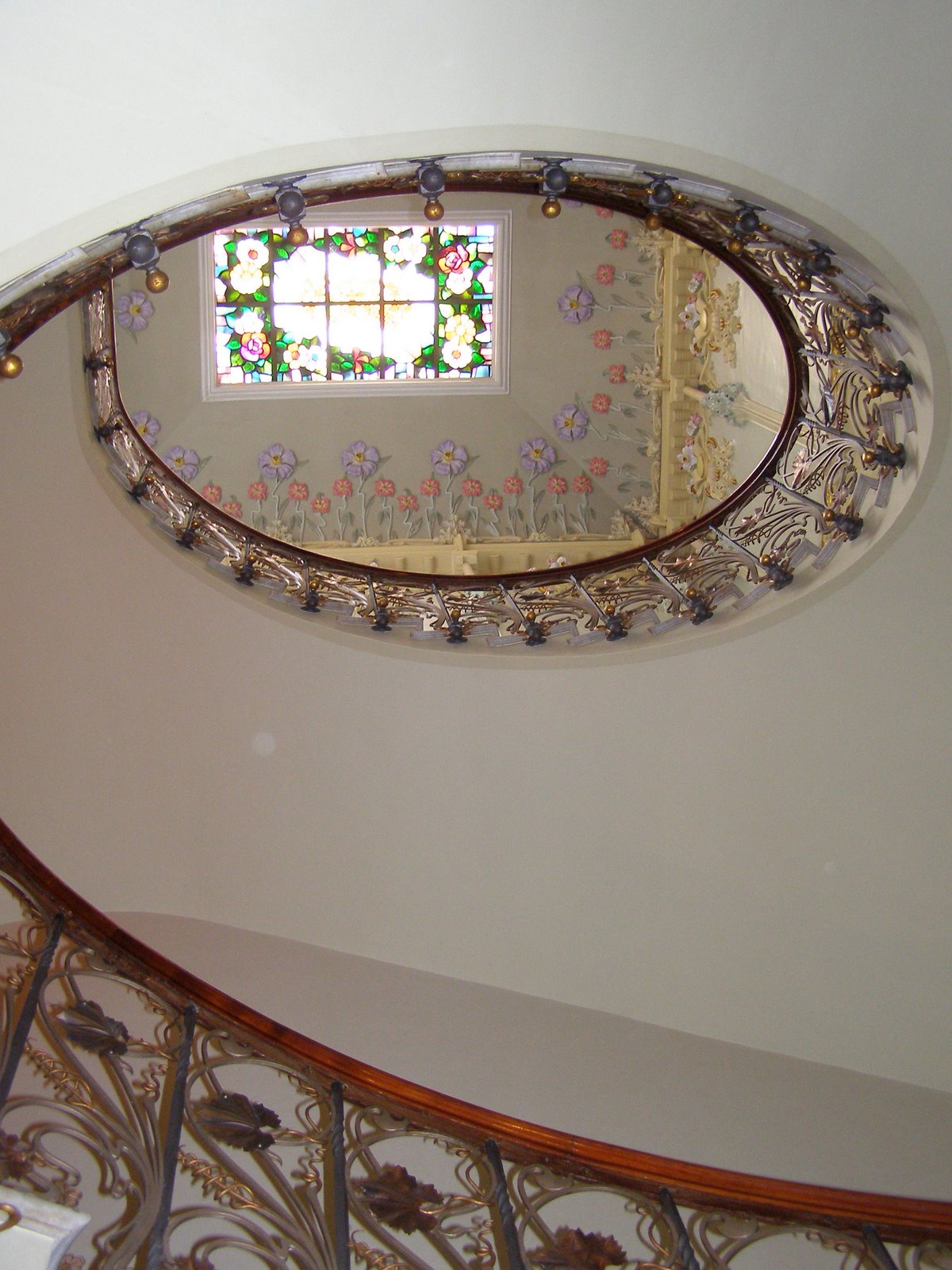
Photo courtsey of Wikimedia Commons Bernhard Hampp
The main Alicante market is another art nouveau icon. When I was taking my intensive Intermediate Spanish course in Alicante in 2012, I used to duck in here every morning to collect my coffee and pastry en route to class.
Mercado Centra has three entrances on different levels. To get to the meat and cheese floor from the entrance on avenida Alfonso el Sabio you climb a central bank of steep steps. If you come through the electric doors from Plaza Mayo this same floor is at ground level.
Take the escalators down and here is the main variety of the market: fish, eggs, fruit and vegetable, cakes and pastries, spices and herbs, plus bars with food and drinks, and a pharmacy. It is a busy place but always a welcome 'cut through' for me.
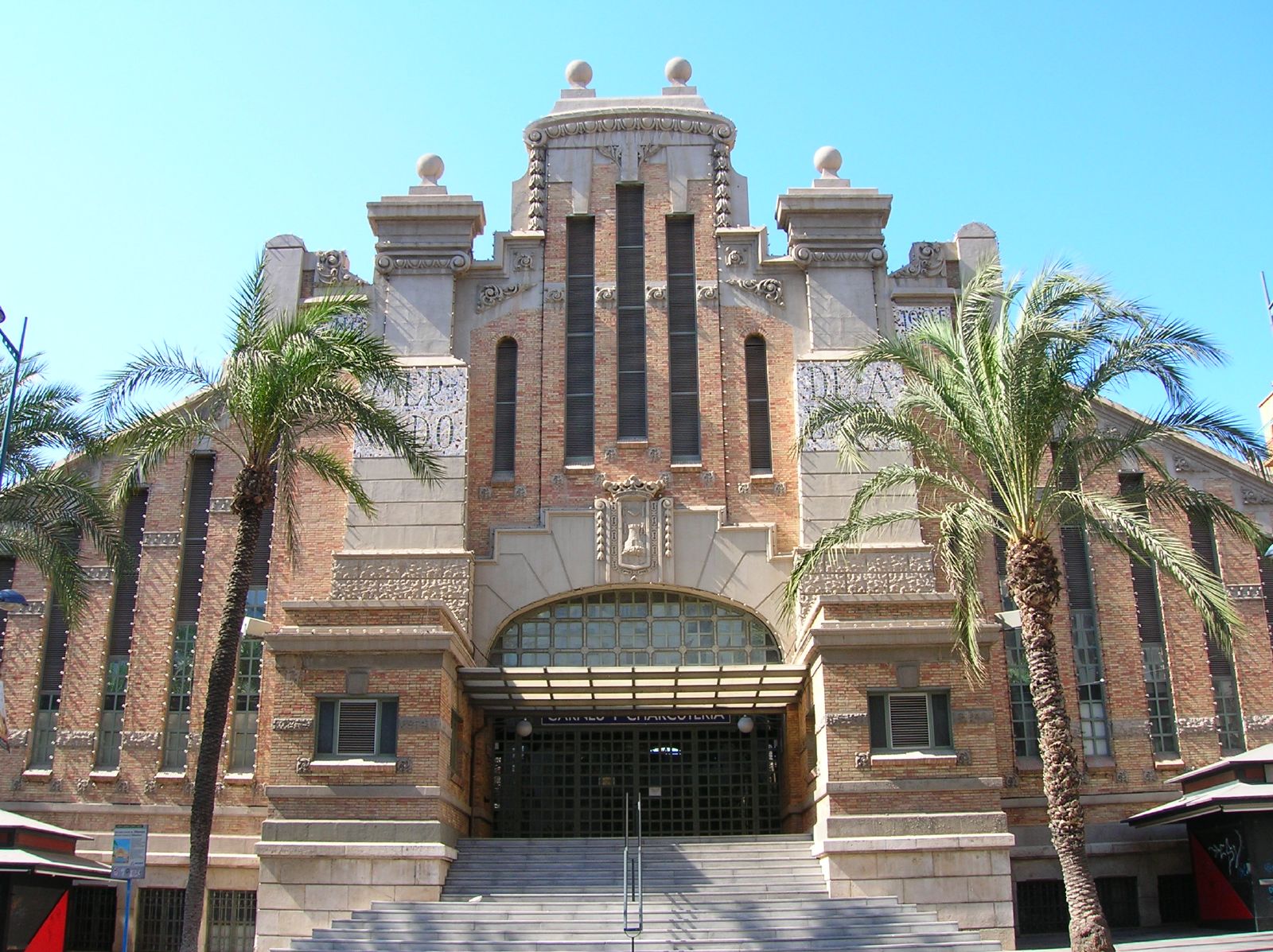
Photo courtesy of Wikimedia Commons bea y fredi
This glitter ball seemed a suitable addition on this street corner as it cast sparkling flecks on the wall of an older building, while reflecting a street length of modern and classic Spanish architecture.
Quirky Alicante
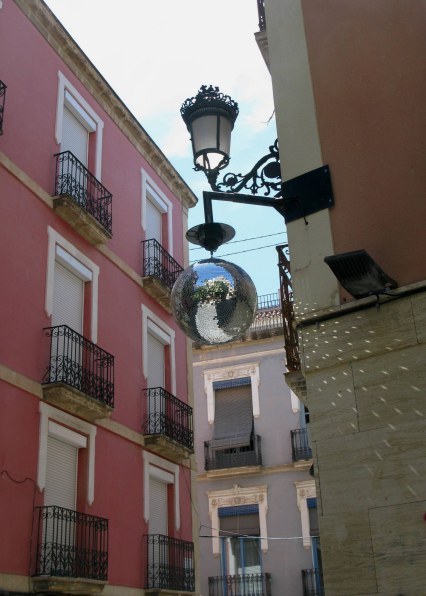
This is a local solution to roller door spray-can 'tagging' - the commissioning of colourful individual murals.
They abound- but not all as evocative as these: the first for digital printing, the second for a supermarket and the third - well self-explanatory really!
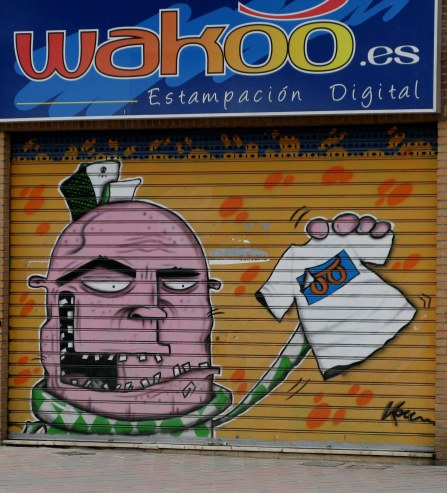
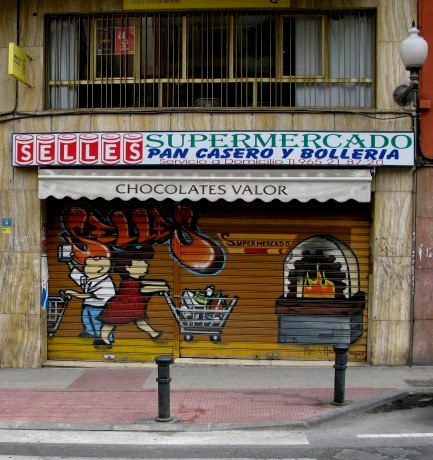
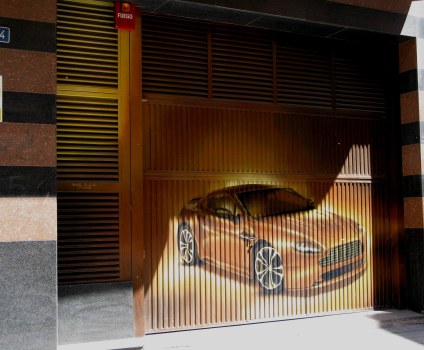
Understanding Spanish meal and refreshment times
The city has a maze of narrow lanes crammed with tapas bars and restaurants that are relaxed in the morning and late afternoon, but come evening they heave with people eating, meeting, and relaxing.
To understand the flow of restaurant dining in Alicante, it’s important to understand the Spanish meal times and the expectations of what is to be on the menu with each.
Here is a description together with the times of Spanish meals:
At around 7:30 am there is breakfast or el desayuno, normally consisting of a coffee, and perhaps a croissant, or more often a tostada which is a slice of baguette with either just butter or also loaded with tomato or cheese.
Then, about 11am we have el amuerzo - a break for a coffee and a snack to tide over a growling stomach until about 2:30pm, when comes the main meal of the day, la comida. You'll note that each name has gender.
Spanish, like French and German, has gender attached to nouns, although German is the only one of the three to complicate things further by adding in a neuter gender. This is why when you encounter people learning German they are likely to mutter “der, die, dass” a lot, as it is somewhat perplexing as a non-native speaker to apply these correctly. This is the defeat of many as they struggle to master German grammar.
In Spain, it is interesting to note that the dinner or lunch taken in the middle of the day (a several course meal) is the first to take the feminine agreement to the word.
This continues with the meals of the rest of the day, la merienda taken at about 6pm when children come home hungry from school and want a snack - and the final supper la cena taken about 9:30pm at its earliest, or more usually, later. This usually consists of tapas, those small snacks that don’t lie heavily on the stomach overnight.
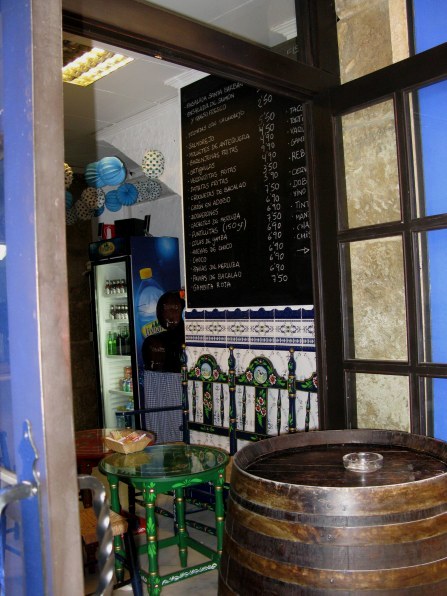
The words for all morning meals or breaks for a snack are masculine.
Apparently one needs the male energy to get through to the big midday meal with its feminine article – and then take a siesta afterwards. (By the way – “siesta” is also feminine).
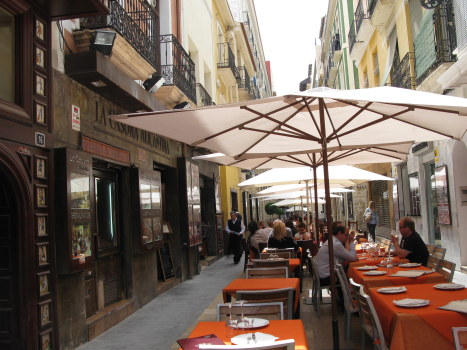
If you wonder why there are few people here in the restaurants of Alicante, these photos were taken during the siesta period.
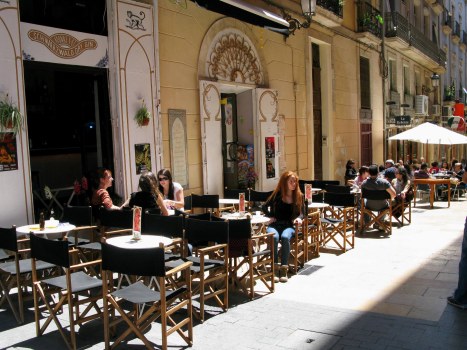
La Nyora Restaurant and Bar in Alicante
If you are looking for authentic Alicante cuisine and delicious food made by Mama from only products of the region, stop at La Nyora at the foot of the pueblo.
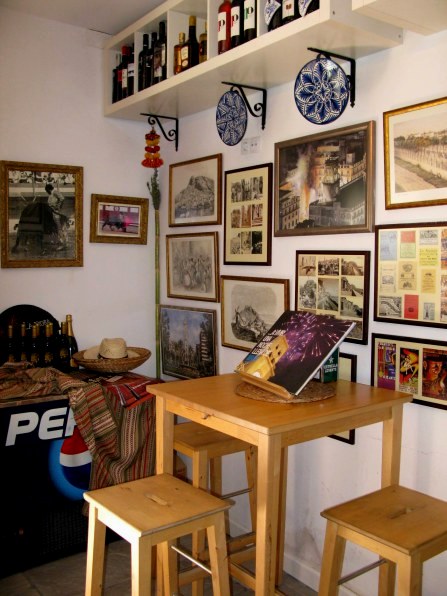
La Nyora is decorated with Alicante memorabilia. To mark the end of my two weeks intensive Spanish course at Proyecto Español, I arranged a special meal there with schoolmates and friends.
During the course of my stay, I had done much of my homework in this bar after a gruelling six hours of study each day.
David, the owner, and his venerable mother, the cook, outdid themselves. The meal left our palates singing - from tasty starters to the Black Rice. Each course was accompanied - or should I say complimented - by a regional wine.
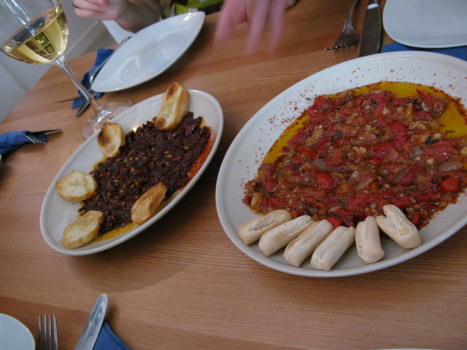
Black rice is made by using cuttlefish, whose blue ink both flavours and colours the rice.
It was through the mistake of me calling it paella that my Spanish friend gave us a lesson in ordering rice.
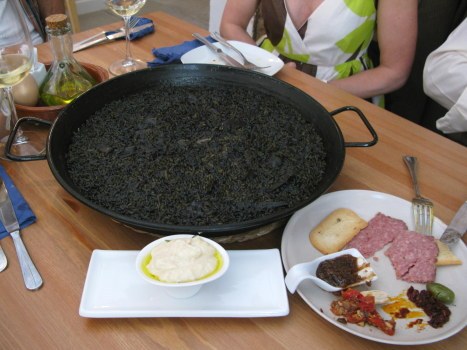
Paella, we were told, is the pan – and also the name given to the person who cooks the rice (paello if a man) - and the contents of the Paella Pan is called 'rice' and not 'paella'.
It is correct to ask to see a menu for 'the rice'.
If you ask for 'paella' you reveal yourself to be someone who doesn’t understand the niceties of Spanish food.
The Alicante Tourist Board gives this recipe for Black Rice.
First catch your cuttlefish!
Black Rice 'de Alicante'
RECIPE for CUTTLEFISH with STICKY RICE
INGREDIENTS FOR 4 PEOPLE
400g rice, 500g cuttlefish, 1 red pepper, 100g flat green beans
100g peas, 100g kidney beans, 100g potatoes, parsley,
garlic, tomato, sun-dried pepper and salt.
METHOD
Sauté the finely chopped tomato, garlic and parsley in virgin olive oil
together with the whole sun-dried pepper.
Add the chopped and prepared vegetables to the frying pan.
Next, add the thoroughly cleaned cuttlefish.
Once all these ingredients are nicely fried, add the rice and fry lightly.
Finally, add 2 litres of water and a pinch of salt. Simmer for 22 minutes.
Back street sights in Alicante
Work hours in Spain in general, and in Alicante as well, are traditionally 9am to 1:30pm, recommencing at 5pm till 8:30pm.
In between, there is time to stroll the streets and take in the sights.
This flower shop had left no doubt about the purpose of its business.
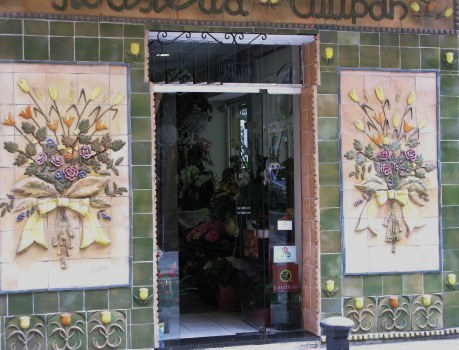
Further along, the 17th century Town Hall was etched against the blue Mediterranean sky, with the castle as backdrop.
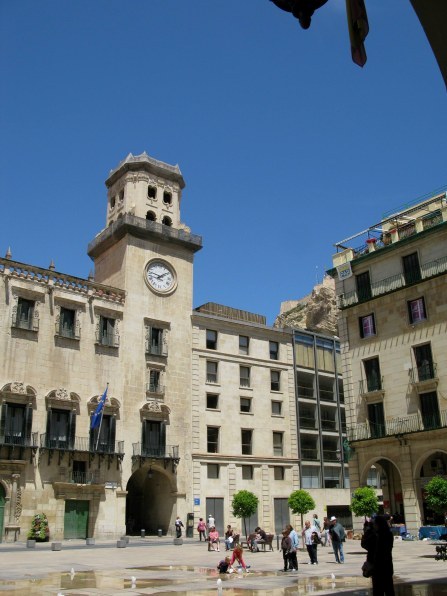
The heavy doors bear the hallmarks of the craftsmanship of the era, with beautiful locks and handles.
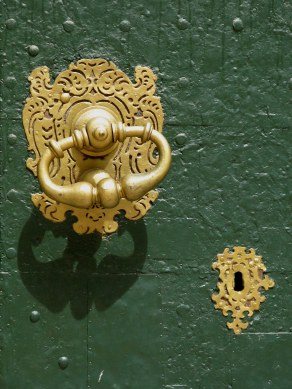
In the plaza in front of the Town Hall children were enjoying the variable levels of the fountain.
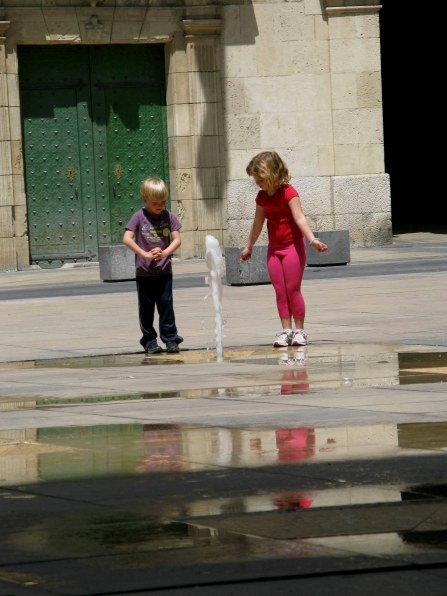
The fun of it all was a magnet pulling other youngsters to join in, and for the rest of us to watch, smiling.
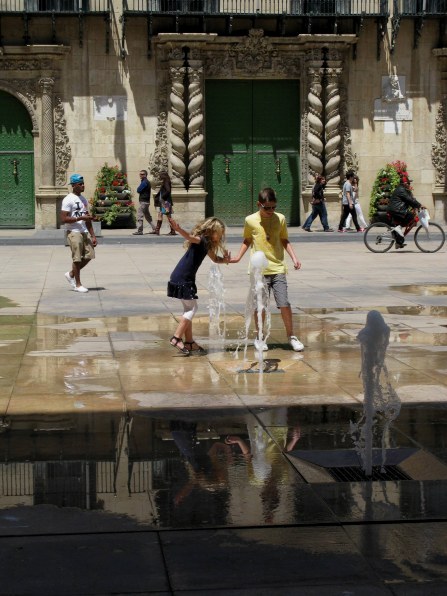
Under the colonnades on the other side of the square was another magnet – but this time not for children: a book fair.
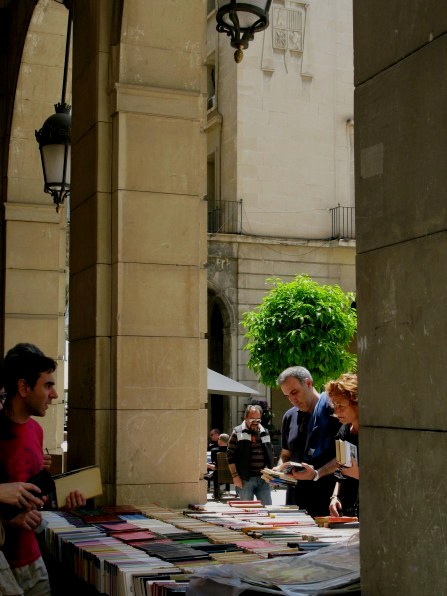
Bar/café Soho in Plaza de Elche Alicante
In siesta time wanderings, or in the warmth of the evening, a great place to relax or to meet friends is under the 100 year-old fig tree on Plaza de Elche at the Bar / Café Soho, in the little park of the same name.
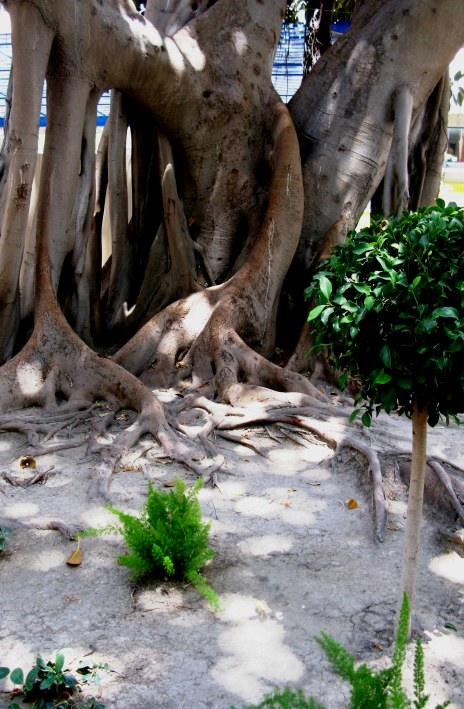
If you need to find the toilets, ask for the code. The toilets are located behind a white door a little way along an adjacent street.
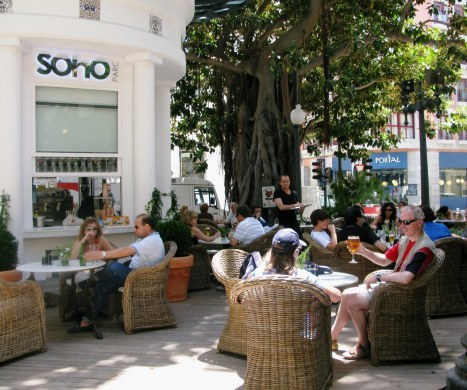
Port of Alicante
In 1851, Alicante was linked by train to Madrid. It was therefore the port to the hub of Spain.
It is still an important port city, and from the castle there is a great view of the marina and port.
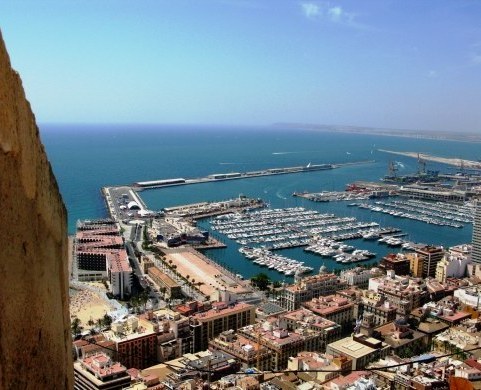
In the 15 century, Alicante exported wool, olive oil, wine, oranges and rice from the Kingdom of Valencia. Then King Felipe III expelled the descendants of the Moorish conquerors who had built the terraces and agricultural infrastructure which had driven such productivity.
With the loss of this expertise, the former wealth of the nobility fell into decline. This was made worse by Felipe punishing Alicante for backing his rival Carlos in the Spanish Succession War, which he won.
With the economy therefore stifled, the region fell back on the production of oranges and almonds, on fishing, and on shoe making – with Elda, about 30 minutes from the Alicante airport being now the centre of that trade.
Fishing is also still a prominent industry, and in the restaurants and taverns you can savour the daily catch.
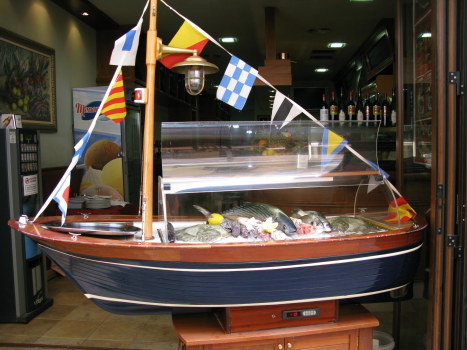
In the streets of the pueblo you see that this relationship of Alicante and the sea is never forgotten.
One of the lane ways is named after St Elmo, patron saint of fishermen - his legendary ability to summon and manage storms being part of his working of miracles.
It seemed to me on reflection, that the strange form of lightning which carries St Elmo’s name must appeal to the Spanish love of celebratory explosions and fire.
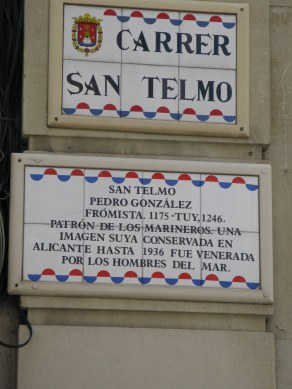
Alicante remained under the control of Madrid until the transition following the Spanish Civil War in 1975. Then, Franco was replaced by the democratic monarchy of Juan Carlos I – who gave regions back their autonomy.
At this point, finally the region of Valencia was more in control of its affairs.
They long for more.
Walls of the city of Alicante
Over history, Alicante has always been attacked from the sea, and previous attacks have left the remains of cannon shot in the walls.
This entry point into the city heart has long since been tamed to one that now welcomes trading vessels, cruise ships, and small boats of all varieties.
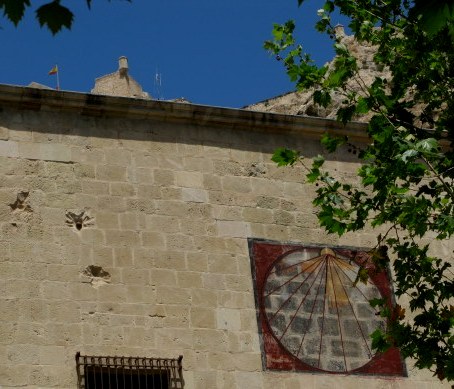
Playa del Postiguet beach in Alicante
The Playa del Postiguet that is within walking distance from the port is a popular beach for city-dwellers and visitors alike to enjoy.
Not many cities boast the ability to walk right down the city streets and onto the sand.
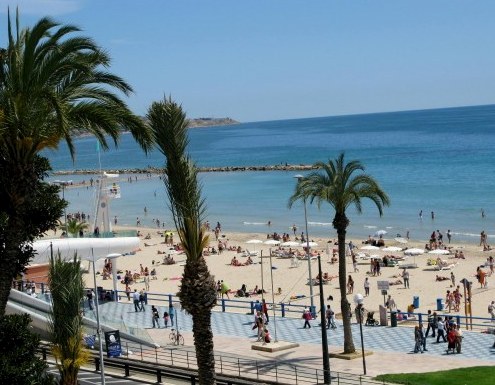
Paseo de la Esplanade in Alicante
Somehow the grace of the Alicante landmark Paseo de la Explanada with its pink marble from the region flanked by ripples of that of black and white, seems to echo the vibrance and relaxed attitude to life that typifies Alicante.
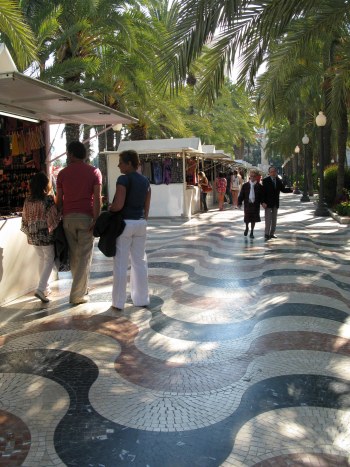
As the unusually large 'Super Moon' of May 2012 rose from behind the coastal cliffs of the Mediterranean, unknowingly I was in a perfect viewing position, for I was walking along an Alicante beach, dreaming dreams.
I stood and marvelled at the moon - only later finding out that such a moment where the moon swings so close to our blue planet will not happen again in my lifetime.
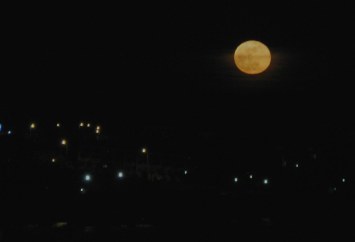
Later, back in my apartment, I was working at my desk when I looked out to see a wedge of moonlight that seemed to be travelling in waves across the Mediterranean towards me.
As the Roman playwright Plautus said:
The day, water, sun, moon, night
I do not have to purchase these things with money
When I look back on my life I have been much blessed by such gifts.
I'm sure we all have - and sometimes it takes a moonbeam to reflect what is important in life.






